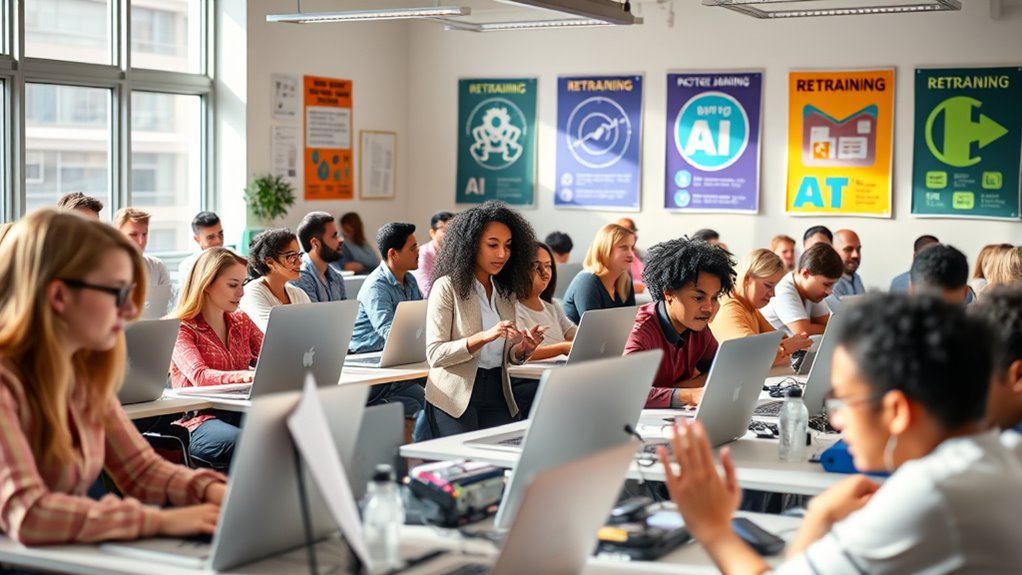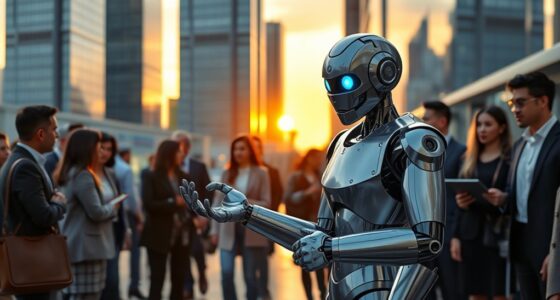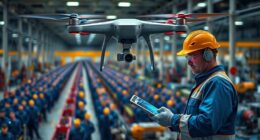While there’s a huge push to retrain workers for the AI economy, the scale and speed of this effort face major hurdles. Nearly 70% of jobs could be affected by AI, but current programs lack the capacity to quickly equip everyone with new skills. Challenges around infrastructure, funding, and access make widespread retraining difficult. It’s possible, but only if governments, employers, and educational institutions coordinate aggressively. To understand how we might overcome these obstacles, keep exploring the details ahead.
Key Takeaways
- Current retraining programs face challenges like limited scalability, high costs, and low long-term retention rates.
- Workforce disparities, access issues, and industry-specific gaps hinder universal retraining efforts.
- Rapid AI-driven job displacement requires large-scale, agile reskilling that existing infrastructure struggles to support.
- Collaboration among employers, governments, and educational institutions is essential but remains inconsistent.
- Complete retraining of everyone for the AI economy is unlikely without significant systemic investment and strategic planning.
The Growing Demand for AI Skills and Workforce Adaptation

As AI continues to reshape industries, the demand for AI skills is growing rapidly, prompting companies worldwide to adapt their workforces. The global AI market is valued at around $391 billion, with private investments in generative AI reaching $33.9 billion—an 18.7% increase from 2023. Nearly 83% of companies see AI as a top priority, and by 2025, up to 97 million people will work in AI-related roles. This surge drives significant industry transformation, boosting productivity and innovation. Organizations are focusing on building skills in AI, machine learning, and data analysis to stay competitive. Critical roles like AI engineers and data scientists are expected to be among the top jobs, emphasizing the urgent need for workforce adaptation. Understanding cookies and data privacy is essential for organizations to ensure compliance and build trust with users in this evolving landscape. Additionally, ongoing workforce retraining efforts must be strategic and comprehensive to effectively meet the evolving demands of the AI economy. Recognizing the importance of technical proficiency in AI tools and platforms is vital for preparing the workforce of the future. Moreover, incorporating home improvement strategies such as regular assessment and organization can foster a more productive learning environment during training initiatives. It is also important to stay informed about AI security vulnerabilities and safety measures to protect organizational data and maintain trust.
The Scale of Retraining Challenges in a Rapidly Evolving Economy
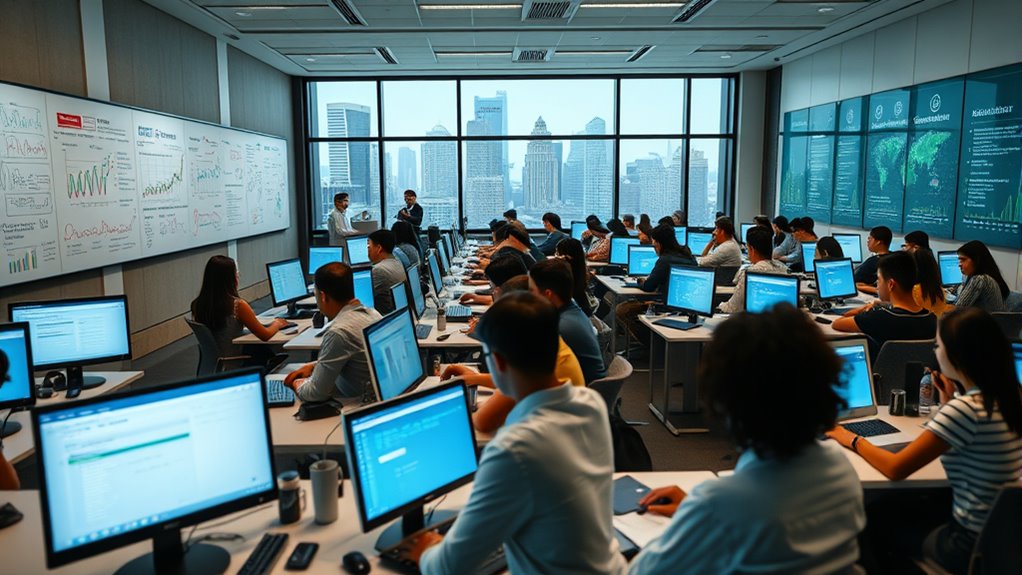
Retraining workers at the scale needed to keep pace with rapid AI-driven changes presents formidable challenges. Existing programs like JTPA and WIA show limited long-term success in boosting employment or earnings, raising questions about their effectiveness. While some programs retain about 70% of workers post-retraining, the lack of control groups makes it hard to assess true impact. The accelerating pace of AI job displacement demands swift, widespread retraining, yet current efforts aren’t designed for such urgency. Workforce diversity, varying skill levels, and access gaps complicate uniform solutions. Additionally, 75% of businesses struggle to find AI talent, and high demand outpaces retraining supply. Organizational capacity strains under burnout, inadequate trainers, and limited tailored resources, further hindering large-scale, effective workforce adaptation. Global workforce data indicates that over 50% of jobs could be affected by AI in the coming years, highlighting the urgent need for scalable retraining initiatives. Moreover, training infrastructure remains underdeveloped, making it difficult to deliver the necessary upskilling at the required speed and scale. Building effective training programs that can adapt quickly is essential for addressing these widespread challenges. A comprehensive approach that incorporates technological, educational, and policy solutions is crucial to overcoming these hurdles. Addressing the skill mismatch is crucial for creating a resilient workforce capable of thriving amid technological shifts. Incorporating training programs with practical components can improve real-world applicability and success rates.
Industry Disparities and Uneven AI Adoption
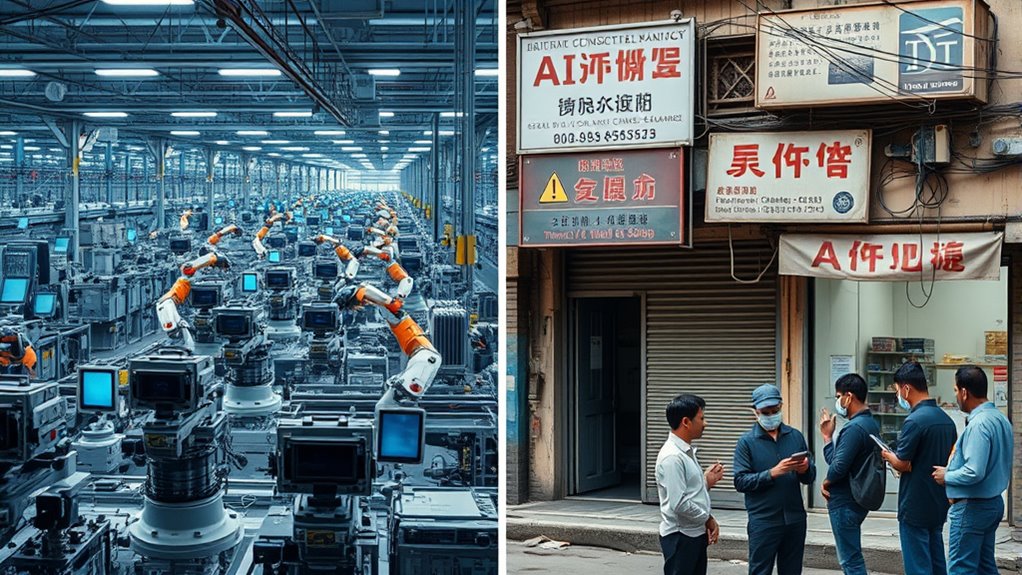
AI adoption varies widely across industries, shaping the pace and nature of workforce transformation. Tech sectors lead the way, while agriculture and education lag due to regulatory and infrastructural hurdles. Manufacturing shows high AI integration, with projections of $3.78 trillion in economic impact by 2035, highlighting heavy investment. Retail and wholesale industries adopt AI for supply chain efficiency and customer engagement, with adoption rates around 44-46%. Financial services quickly incorporate AI for personalized recommendations and sales tools. However, industries like healthcare and education fall behind, hampered by ethical concerns and complex regulations. These disparities also reflect regional differences, with developed economies adopting AI faster than developing regions. Such uneven adoption intensifies economic divides and complicates workforce retraining efforts across sectors. Regional disparities further influence the speed and scope of AI-driven economic growth, often leaving less developed areas at a disadvantage. Additionally, workforce retraining initiatives are essential to bridge these gaps and ensure equitable economic progress. Furthermore, the market growth projected at over 40% CAGR in AI tech by 2025 underscores the rapid evolution and increasing importance of AI across sectors. Recognizing the diverse pace of AI adoption among industries can help tailor effective retraining strategies to address these disparities. Expanding access to eco-friendly technologies like sustainable energy solutions is also crucial for fostering inclusive economic growth and environmental sustainability.
Moreover, technology integration in workplaces can facilitate smoother transitions and better adaptation to AI-driven changes.
Balancing Job Creation and Displacement Risks
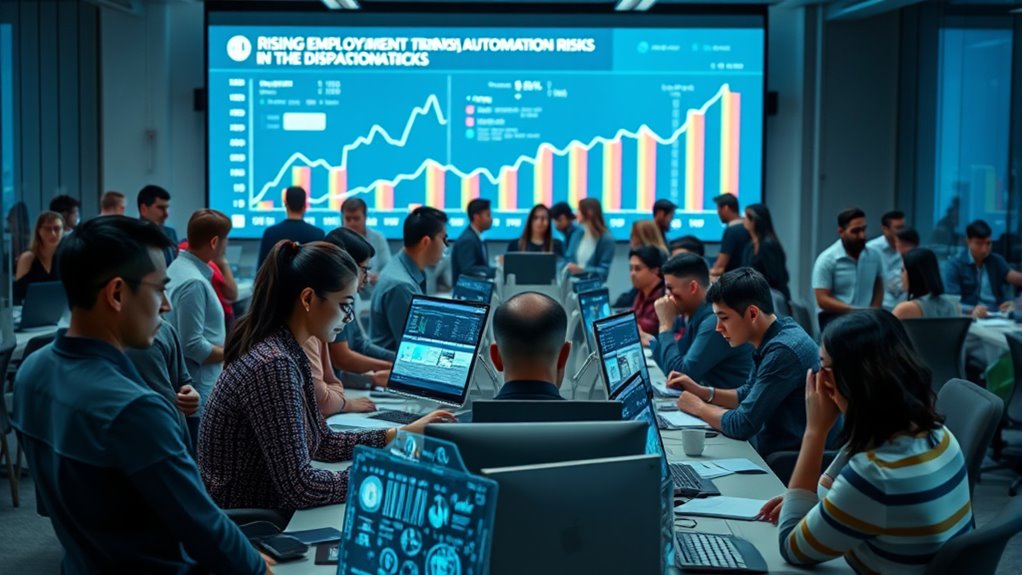
Balancing job creation and displacement risks requires carefully managing how automation impacts the workforce. You need to understand that AI will displace jobs, especially in routine tasks—40% of employers plan reductions where automation fits. However, AI also creates new roles in data analysis and problem-solving, with a net gain of 58 million jobs globally by 2025. The impact varies by region and industry; manufacturing faces displacement, healthcare benefits. To visualize, consider:
| Displacement | Shift | Opportunities |
|---|---|---|
| Routine jobs | Reskilling | New roles in AI tech |
| Regional impacts | Skills gap | Creative and analytical skills |
| Entry-level decline | Investment | Growth in professional fields |
| Global effects | Workforce shifts | Enhanced productivity |
Balancing these forces demands targeted policies, adaptable skills, and strategic investments. Additionally, fostering reskilling initiatives can help mitigate the adverse effects of automation on vulnerable workers. Developing personality assessments can also assist in aligning workers’ strengths with emerging roles, ensuring a smoother transition. Furthermore, integrating labor market data into workforce planning allows policymakers and companies to better anticipate and respond to industry-specific shifts. Implementing targeted training programs that utilize industry-specific data will further enhance workforce adaptability and resilience.
Resources and Infrastructure for Large-Scale Reskilling
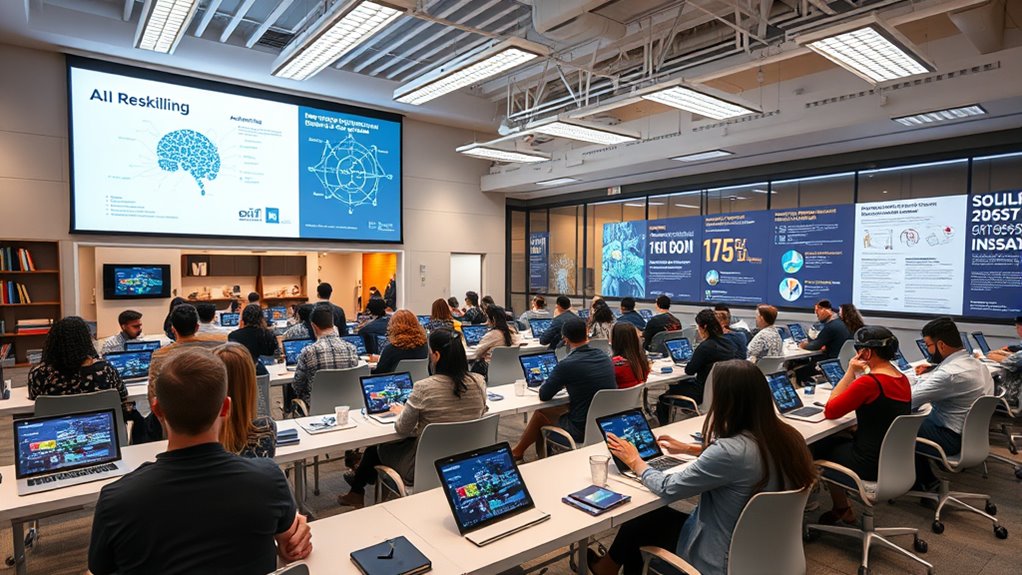
To effectively prepare the workforce for the demands of Industry 4.0, it’s essential to develop robust resources and infrastructure that support large-scale reskilling efforts. You need integrated technologies like AI-powered platforms and adaptive learning systems to make training accessible and efficient. Many organizations already have mature career development initiatives, but expanding these requires investment in innovative curricula tailored to future needs. Collaboration across countries and organizations can help standardize and improve infrastructure, guaranteeing broader reach. Additionally, implementing predictive analytics can help identify skill gaps before they become critical issues. Building support hours and flexible training schedules into reskilling programs can improve participation rates and accommodate diverse learner needs. Moreover, investing in digital learning tools can further enhance training effectiveness and engagement. However, challenges like reaching remote or underdeveloped areas, predicting skill gaps, and managing costs remain. Building institutional capacity and overcoming social barriers are vital for success. With the right investments, these resources can accelerate workforce adaptation and ensure economic resilience amid rapid technological change. According to recent studies, investing in reskilling infrastructure can lead to a significant return on investment by enhancing workforce productivity and adaptability.
The Role of Employers, Governments, and Educational Institutions

Employers, governments, and educational institutions each play an essential role in shaping the workforce for the AI economy. You’ll find that employers are investing heavily in reskilling, with 77% planning to prioritize workforce upskilling by 2030. They aim to accelerate automation and integrate new tech, but cultural resistance remains a challenge. Governments are vital for expanding digital access and funding public education, with 60% emphasizing its importance for future growth. They also need to address disparities between economies and foster public-private partnerships to support worker transitions. Educational institutions must revamp curricula to include AI literacy and digital skills, promoting lifelong learning and collaboration with industry. Together, these stakeholders must coordinate efforts to align goals, share data, and overcome organizational barriers.
- Reskilling initiatives driven by employer investments
- Policy support for digital access and equity
- Curriculum updates emphasizing AI and tech skills
- Public-private partnerships for workforce development
- Data sharing to identify skill gaps and measure progress
Leveraging AI to Facilitate Worker Retraining
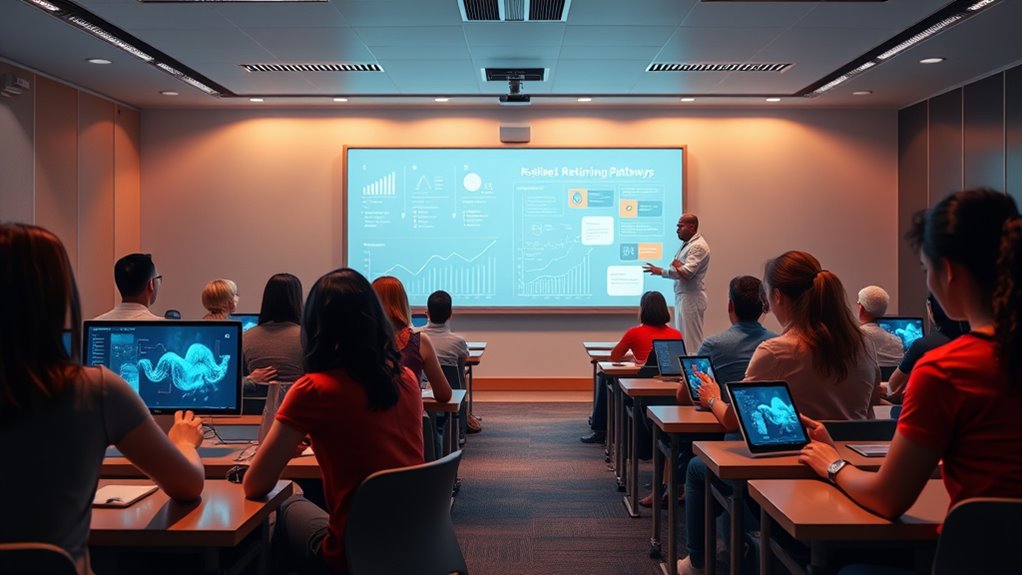
As organizations and educational institutions work to prepare workers for the evolving AI-driven economy, leveraging artificial intelligence itself offers powerful solutions for retraining efforts. AI-driven platforms provide personalized learning paths tailored to individual skill gaps and needs, increasing training efficiency. For example, Schneider Electric’s AI recommendations lead to over 300,000 course completions monthly. AI also helps identify workforce skill gaps by analyzing job market trends, enabling targeted upskilling and reskilling. These tools support continuous learning, ensuring workers stay relevant amid rapid AI advancements. They deliver real-time feedback, adapt to diverse learning styles, and boost engagement. By integrating AI into training programs, companies like Amazon transform employees into specialists for high-demand roles, making retraining more effective and accessible for a broader workforce. Strategy and Mastery can further enhance the effectiveness of these initiatives by applying AI-driven content clusters to organize and scale training content efficiently. Additionally, incorporating wall organization solutions can help create a structured learning environment that fosters employee motivation and progress. Furthermore, as automation continues to evolve, these training methods ensure that workers can adapt to new technologies quickly and effectively. Moreover, utilizing learning analytics allows organizations to monitor training outcomes and optimize programs in real time. Implementing comprehensive skill assessment tools can further identify specific gaps and personalize learning experiences for optimal results.
Strategies for Building a Resilient and Future-Ready Workforce

To build a resilient, future-ready workforce, you need to foster a culture of continuous learning that adapts to rapid technological change. Leveraging AI-driven skill development programs and forming strong public-private partnerships can accelerate reskilling efforts. These strategies guarantee workers stay relevant and organizations remain competitive in the evolving AI economy.
Continuous Learning Culture
Building a resilient and future-ready workforce depends on cultivating a strong continuous learning culture that aligns with employee preferences and organizational goals. To succeed, you need to take into account what motivates your team—68% prefer training during work hours, and 58% want to learn at their own pace. A learning-focused environment boosts job satisfaction by 83% and increases engagement by 92%. You should:
- Provide flexible learning schedules to accommodate different routines
- Set clear career goals to encourage participation
- Incorporate regular feedback for ongoing improvement
- Ensure equal access to training opportunities for all employees
- Leverage technology to make learning more accessible and engaging
AI-Driven Skill Development
Harnessing AI-driven skill development is essential for preparing your workforce for the rapidly evolving job landscape. AI is transforming roles, with up to 97 million jobs expected in AI-related fields by 2025 and 133 million new positions by 2030. To stay competitive, you need to invest in reskilling initiatives that focus on emerging roles like prompt engineers, AI ethicists, and machine learning specialists. Many companies are increasing AI budgets—by an average of 32% in 2025—and establishing dedicated AI teams. Leveraging AI-powered adaptive learning, virtual reality, and data analytics can personalize training and identify skill gaps quickly. These technologies enable scalable, targeted development, helping your employees adapt to changing demands and ensuring your organization remains resilient in the AI-driven economy.
Public-Private Partnerships
Public-private partnerships (PPPs) play a crucial role in creating a resilient, future-ready workforce by combining the strengths of both sectors. They enhance workforce development, promote financial sustainability, and expand market access. To succeed, you need to engage stakeholders through transparent communication, deliver tangible outcomes like training centers, and guarantee strong project management with clear roles and performance metrics. Aligning long-term goals helps overcome cultural differences and operational challenges, while adaptability ensures the partnership stays relevant to local needs and market conditions. PPPs also address skills gaps, foster diverse talent pools, and prepare workers for emerging jobs through competency-based training. By focusing on these strategies, you can build effective collaborations that develop sustainable talent pipelines for the evolving AI economy.
- Engaging stakeholders through transparent collaboration
- Delivering tangible outcomes like training centers
- Implementing strong project management practices
- Aligning long-term, shared goals
- Ensuring adaptability to local needs
Frequently Asked Questions
How Can Small Businesses Afford Large-Scale AI Retraining Programs?
You wonder how small businesses can afford large-scale AI retraining programs. To manage costs, consider outsourcing AI services, leveraging pre-trained models, and using cloud platforms for scalability. Upskilling existing employees is more affordable than hiring new specialists. Focus on strategic planning, prioritize essential training, and seek partnerships or grants to offset expenses. These approaches help you adopt AI effectively without breaking the bank.
What Measures Ensure Equitable Retraining Access Across Diverse Regions?
Think of equitable retraining access as planting seeds across different fields—you need to foster each one fairly. You can do this by developing inclusive training platforms that reach diverse populations, offering targeted support to regions with limited resources, and fostering partnerships between businesses, governments, and educational institutions. These steps ensure that everyone, no matter where they’re from, has a fair shot at acquiring AI skills and staying competitive.
How Will AI Impact Jobs Outside of Tech Industries Long-Term?
AI will markedly reshape jobs outside tech industries in the long term. You’ll see many roles displaced, especially in manufacturing, sales, and customer service, with automation reducing entry-level opportunities. However, new jobs will emerge, demanding skills that complement AI. To stay ahead, you’ll need continuous retraining and adaptation, as the workforce shifts toward roles that require human-AI collaboration, ultimately changing how you approach your career and skill development.
Can Low-Skilled Workers Realistically Transition Into High-Tech Roles?
Think of shifting into high-tech roles as climbing a steep hill. As a low-skilled worker, you face significant barriers like digital literacy gaps and systemic inequities. While federal programs and incentives are helping, retraining isn’t always easy or quick. You’ll need ongoing support, learning opportunities, and access to resources. It’s possible for many, but it requires effort, perseverance, and a commitment to continuous skill development.
What Policies Are Most Effective for Encouraging Continuous Workforce Learning?
You can encourage continuous workforce learning by implementing policies that promote ongoing training and development. Offer incentives for companies to invest in upskilling, support public-private partnerships, and fund vocational programs. Emphasize accessible, tailored training content, and foster a culture of lifelong learning. Regularly evaluate training effectiveness and align programs with business goals. By creating an environment where learning is valued and supported, you’ll help workers adapt seamlessly to technological changes.
Conclusion
While retraining everyone for the AI economy might seem like chasing a mirage, it’s not impossible if you view it as a collective journey rather than a solo race. With strategic effort from governments, industries, and educators—like gears in a well-oiled machine—you can help build a resilient workforce ready for tomorrow. Don’t just watch the future unfold; be part of shaping it, turning challenges into opportunities that benefit us all.
